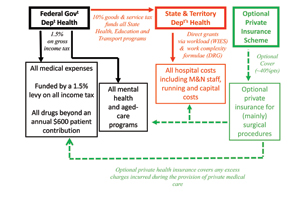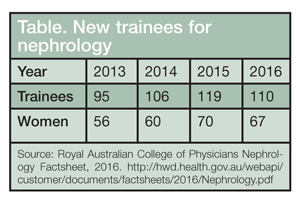Optimism seen for Australian nephrology workforce
In 2006, the Australian and New Zealand Society of Nephrology held its biennial Dialysis and Transplant Workshop in Queensland, Australia, attended by all binational heads of units and other invited nephrologists. A key discussion item was an assessment of the manpower predicament for Australian and New Zealand nephrology.
I had published a paper in 2008 for the official journal of the Royal Australian College of Physicians, which outlined a rather grim forward projection for Australian and New Zealand nephrology.1 The 2008 new trainee intake was almost matched year-on-year with projected retirements, while those intending a clinical career seemed in close lock step with those who chose academic nephrology. It was not an encouraging landscape for clinical care.

Ten years later
The Royal Australian College of Physicians Nephrology Factsheet 2016 paints a more optimistic picture – though New Zealand is not represented in the report.2 In 2016, the 428 of the 479 employed nephrologists in Australia self-reported as clinical nephrologists, with 33 in primary research positions. A few were streamed into administration (12) and fewer (six) named education as their primary focus. The average age was 48.8 years old, with 15.2% being 60 years old or older. Of the group, 29% indicated they intended to retire in fewer than 10 years. The mean work week was 39.5 hours. Of the workforce, 28.5% were women. See Table for the important trainee count. Four out of five nephrologists (81.3%) practiced in a major city, with 10.5% in regional cities with a population fewer than 50,000.

Training
Becoming a nephrologist in Australia is a rigorous process. Following completion of a 5-year university-based undergraduate medical degree and 4 years of post-graduate hospital-based years in basic physician training, advanced training in nephrology requires an additional 3 years that includes a full year attached to a designated transplant service, in addition to curriculum- mandated training in home hemodialysis (recommended target [RT]: 10 patients), home peritoneal dialysis (RT: 50 patients) and center-based hemodialysis management (RT: 50 patients.)3 Post-fellowship clinical PhD options have been established in the past decade to sustain and retain clinical career paths. This has undoubtedly strengthened the stream to clinical nephrology. All this should be understood in the context of the Australian health care system (see Figure).

Nephrology remains a predominantly “public” specialty with an earning capacity that lags two to three multipliers behind the interventional specialties of cardiology and gastroenterology. However, it appears that nephrology – when practiced well and comprehensively across its multiple platforms – remains a more interesting, challenging and rewarding career.
- References:
- 1. Agar JWM. Int Med. J. 2008. 38(3):211-215.
- 2. http://hwd.health.gov.au/webapi/customer/documents/factsheets/2016/Nephrology.pdf
- 3. www.racp.edu.au/docs/default-source/default-document-library/nephrology-advanced-training-curriculum.pdf?sfvrsn=2
- For more information:
- John W.M. Agar, MBBS, FRACP, FRCP(Lond), OAM, is the conjoint clinical professor of medicine at the University Hospital Geelong and Deakin University School of Medicine Renal Unit, University Hospital, Geelong, Victoria, Australia.
Disclosure: Agar reports no relevant financial disclosures.
